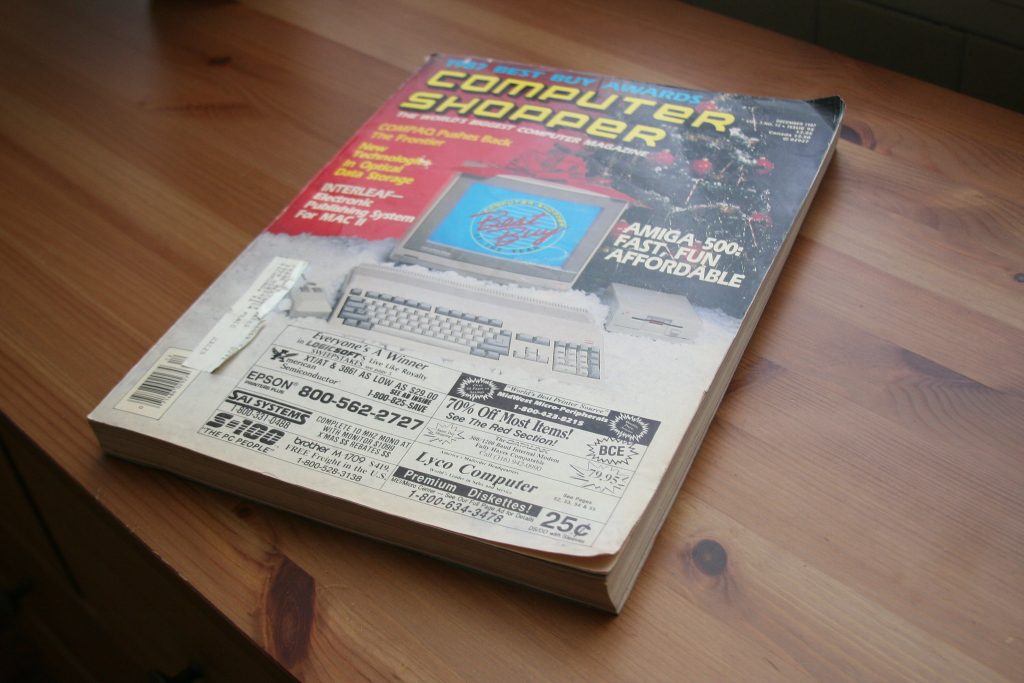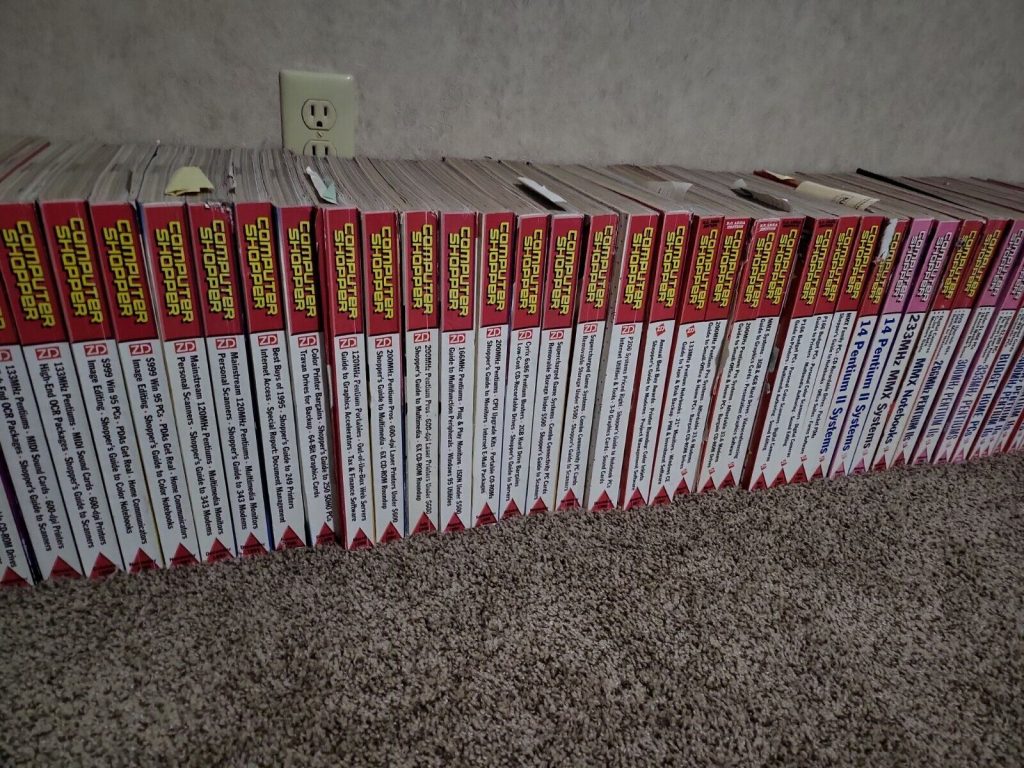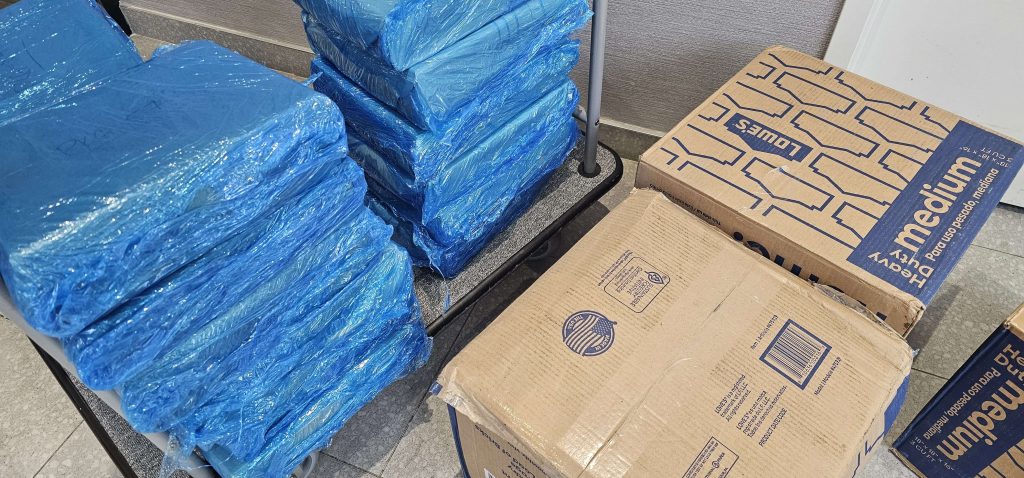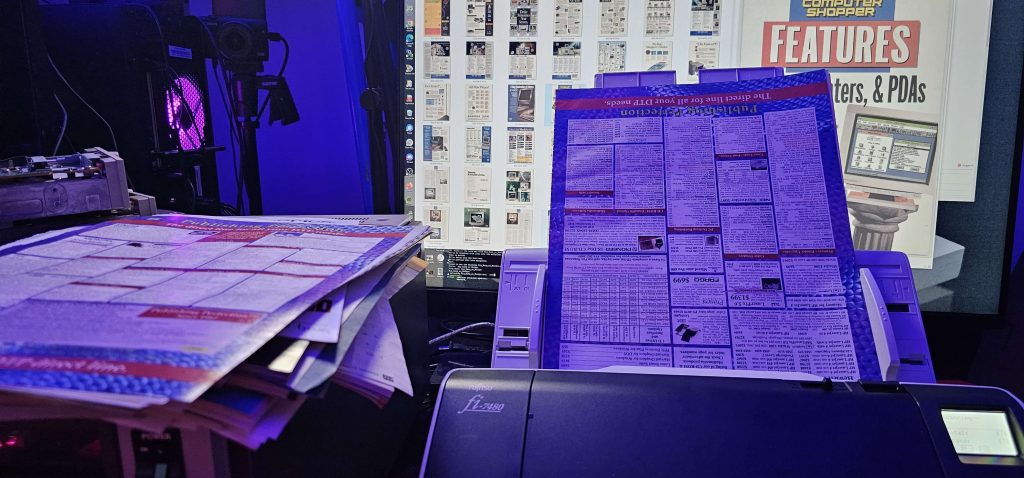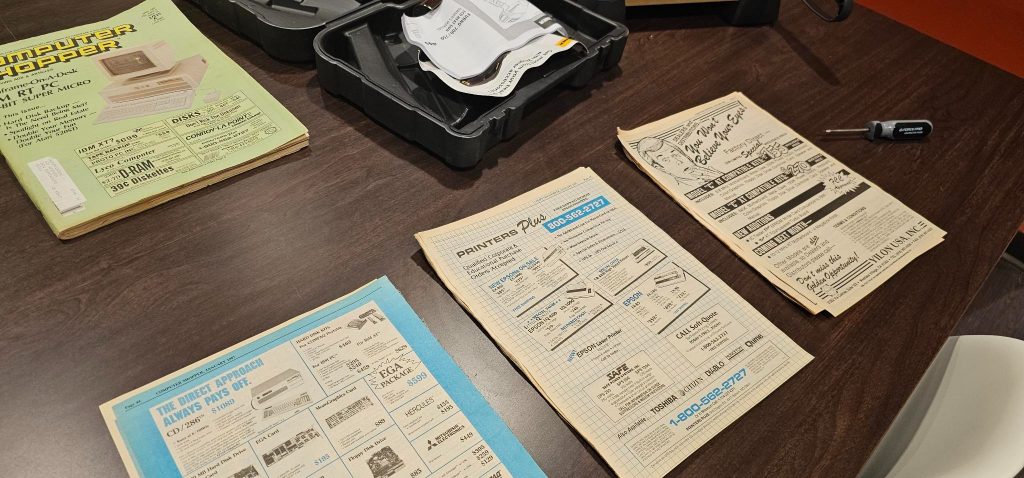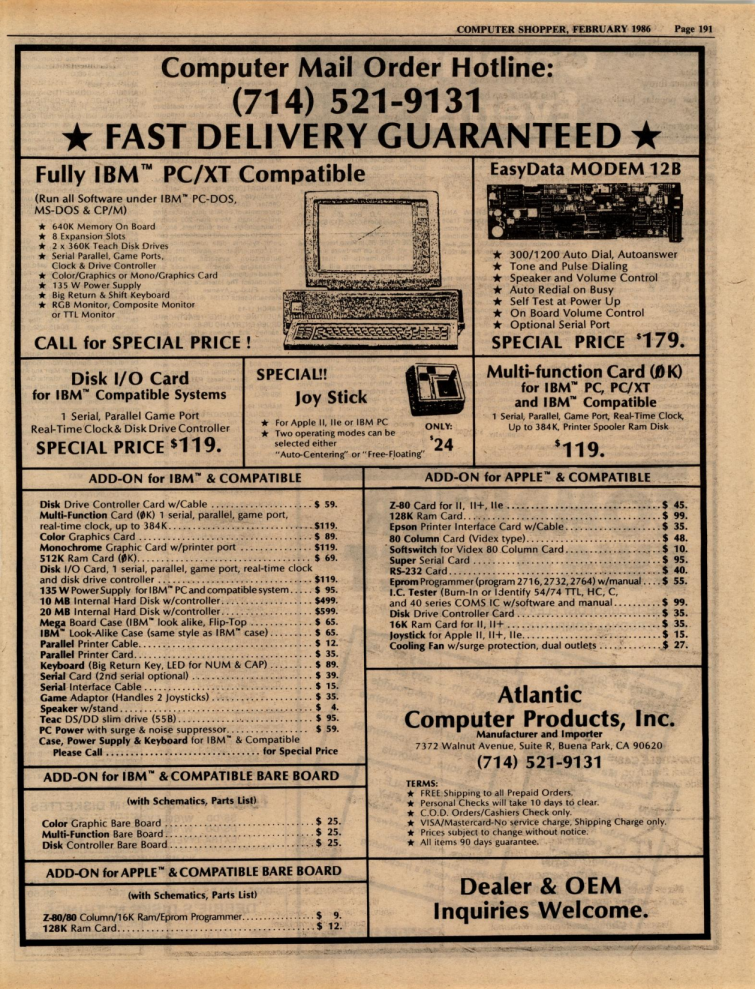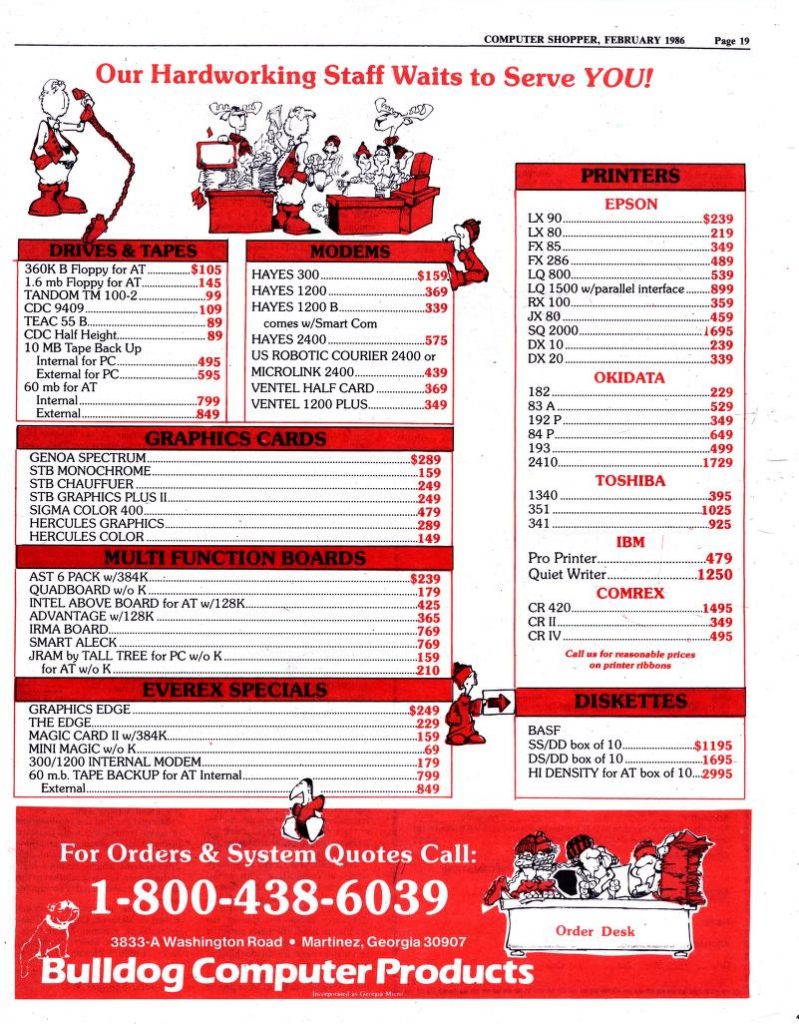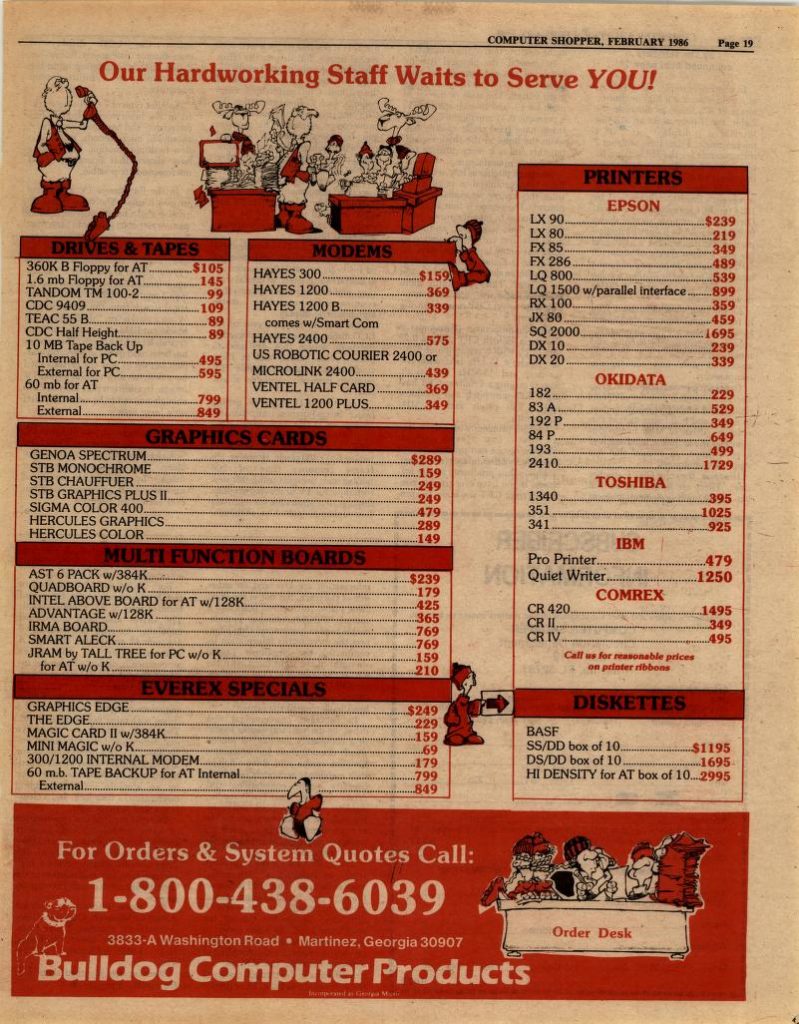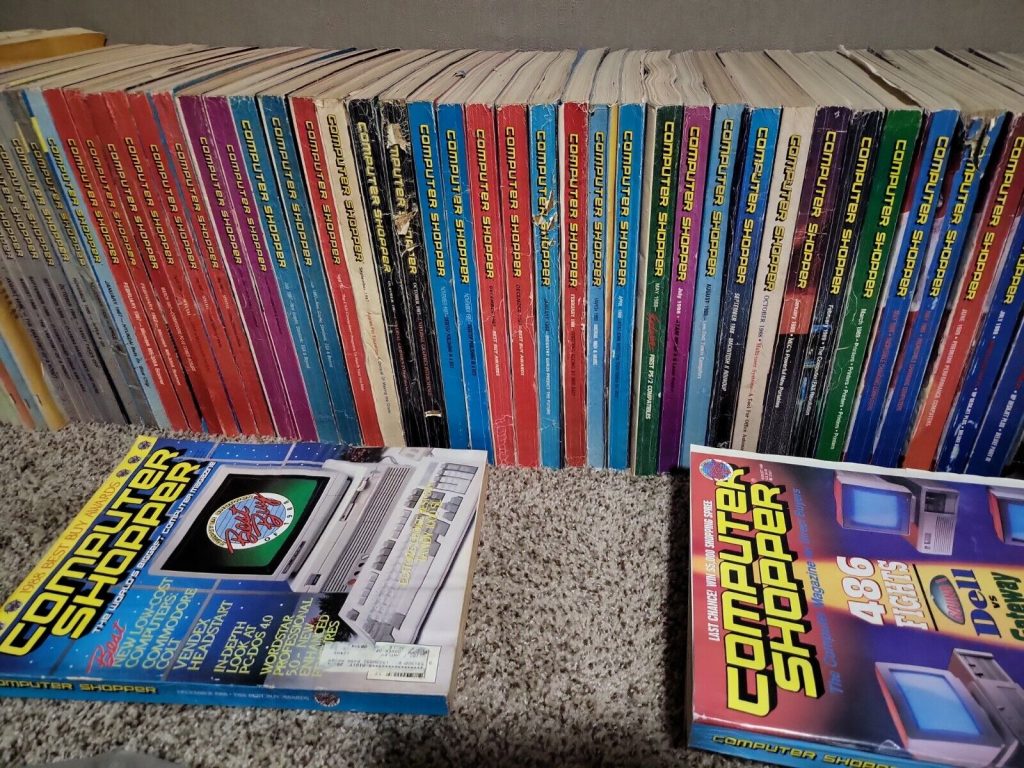

Preparing for the Incoming Computer Shopper Tsunami
source link: http://ascii.textfiles.com/archives/5543
Go to the source link to view the article. You can view the picture content, updated content and better typesetting reading experience. If the link is broken, please click the button below to view the snapshot at that time.

Preparing for the Incoming Computer Shopper Tsunami — June 5, 2023
There’s no way for me to know where your awareness starts with all this, so let’s just start at the beginning.
Computer Shopper was a hell of a magazine. I wrote a whole essay about it, which can be summarized as “this magazine got to be very large, very extensive, and probably served as the unofficial ‘bible’ of the state of hardware and software to the general public throughout the 1980s and 1990s.” While it was just a pleasant little computer tabloid when it started in 1979, it quickly grew to a page count that most reasonable people would define as “intimidating”.
In a world that saw hundreds of magazines and thousands of newsletters come and go about technology and computer-related subjects, Computer Shopper was its own thing entirely. Not only thick as a brick, but clearly opened to anyone who waved cash and covering vendors who were selling computer components down to the individual part level. You might have a good set of ads in PC Magazine but to browse over price lists of capacitors, power supplies and wiring, the massive monthly Computer Shopper issue was going to be your go-to.
There were two other aspects to Computer Shopper that has given it a halo of intrigue and positive memory: First, the paper was incredibly cheap, newspaper tabloid level by some eyes. This seeming disposability infers a weird sort of honesty about the advertising contents – it is what it is, it represents what the actual pricing is, and what’s actually available. The lack of pure slickness in the printing process was a baggage of “look, I’m lucky if we survive another month and this is the straight up price we’re offering” across the many hundreds of ads in a given issue.
But second, was the full-bore willingness to seemingly absorb anything computer adjacent into its pages. Pre-fab computers and commercially available software was listed inside, sure. But if you were selling tech clothing, clips, floppies, tapes, plugs, paper, switches and accessories… you had a home there as well. It gave a truly manic and freewheeling melee to the affair, and for those of us who wanted to know more than the standard 20-30 software packages everyone was buying, or to think about smacking together a bunch of parts to get a mutant-powerful system up and running, this was the place.
To a smaller set of us, the BBS Listings in the back were also a very notable aspect. BBS operators across all the spectrum of cliques and locations thought of Computer Shopper as the BBS yellow pages, the phone book of the online, for almost its entire run. You flipped to the back, found your area code or state, and downright eye-watering levels of BBS listings were waiting for you. Inaccurate? Sometimes. But a truly unique assemblage of what was.
That catches us all up to what Computer Shopper was. Like many print-based computer magazines, Computer Shopper grew in size into the many of hundreds of pages, some greater than 800. It thrived in the world before the World Wide Web took hold, and once you could do daily updates of parts and prices at various websites, the months-lag in printing schedule and the lack of responsiveness compared to websites made it lose curry, favor, and eventually pages. It died a quiet death in 2009, becoming a barely interesting site and then an uninteresting zombie.
Still, it was a heck of a run.
People often ask me the same basic questions regarding old computer history and access to it. One of them is to discuss potential holy grails, possibilities of where some effort might be afforded to acquire potentially lost information or artifacts before they’re gone.
A common go-to for me was Computer Shopper, because it’s a perfect storm of absolute fascination and completely intolerable amounts of barriers towards digitizing it into something readable online.
- It’s fantastically huge. If you scan in an issue, however you do it, you’re talking hundreds of pages for that month, all of them requiring babysitting to ensure they got through.
- The cheap, cheap paper is a nightmare to run through a scanner – either a flatbed-based misery or a sheet-fed scanner that’s one molecule of damage away from crunching pages up.
- The gutters (space between the spine and the information on the page) is offensively small – millimeters where there should be a half-inch. Especially towards the 1990s era, the instructions to advertisers about layout clearly didn’t make many bones about informing folks about margins. This means the books have to be split apart, a despicable sin that strikes against the heart of the pure.
- These myriad, no-gutter, cheaply-printed pages are both tabloid size and never considered text too small to allow. This means that not only is the page size not going to fit in 95% of the consumer scanners out there, but they’re going to need to be scanned at the highest level you can, to not miss anything. The page size, digitized, is going to be offensively huge.
So, the prospect this would ever happen was basically zero. You needed someone who had the time, inclination, and support to do what was going to be one of the more painful scanning projects extant.
It turned out to be me.
So, there I was whining online about how it was 2023 and nobody seemed to be scanning in Computer Shopper and we were going to be running into greater and greater difficulty to acquire and process them meaningfully, and I finally, stupidlysaid that if we happened on a somewhat-complete collection, I’d figure out how to do it.
And then an ebay auction came up that seemed to fit the bill.
Out in Ohio, someone decided to sell nearly 200 issues of Computer Shopper for a few thousand bucks.
It’s important to understand the usual per-issue prices for Computer Shopper, and that usual per-issue price can get as high as $50 an issue. Obviously, at some large scale, this becomes an untenably large price. But in this case, they were being sold for about $13 an issue, which is not zero, but somewhere in the realm of manageable: About $3,000 for the lot.
Now, I’m not going to have $3,000 to throw around like that. So I put the challenge out there: If people get together and give me $3,000, I’ll buy this lot and scan it it.
It hit goal in about 3 hours.
As you might have figured out, delivery/mail was not an option. To make that happen, I reached out for a volunteer, and a few people came forward, including Wes Kennedy, who made this his main project for a few days. He’d left one job and was starting another a week later, and “picking up all the issues, packaging them carefully, and putting them in the mail to Jason” became his fun-cation. He deserves all the kudos for this.
When 14 large boxes arrived, they included all the issues, put inside large paper envelopes and wrapped in blue plastic that definitely didn’t look like cocaine to the storage unit guys I cruised past.
So all of the issues were now safely within my control.
One might be inclined to say “Well, that’s only half the problem.” and you’d be off, because it’s actually less than a quarter of the problem. Acquisition, after all, was just money – buying issues in bulk and ending up with a good amount of them was just a case of assembling some cash.
No, it was definitely the scanning that was going to be the big …. issue.
If not obvious, the pages of this tabloid-sized periodical are not just big, they’re over the bounds of pretty much every scanner out there, at least in the consumer space. (There’s plenty of large-format scanners past the $5,000 range, and they’re also gargantuan affairs, meant to handle blueprints and posters.)
But I did find one commercial scanner that could do the work: A Fujitsu fi-7480 wide-size sheet-feed scanner, which tops out at about $3,500. I’ll simply say a kind anonymous donor bought it outright so I wouldn’t have to crowdfund for it, and for that I’m eternally grateful.
Here’s what dealing with that process looks like, with the scanner software (Vuescan) set carefully to neutral and pulling in the massive pages through the fi-7480:
…which brings up the situation involving the pages.
Now, about 12 years ago, I really raked someone over the coals for destroying copies of BYTE magazine to scan them. He was not happy about this at all, and there’s a chance he may have stopped his project just not wanting to deal with such criticism. I hope not, but I do stand by the fact that he indicated he was immediately disposing of the pages after scanning them, which meant any mistakes or oversights were permanent. (At one point, he mentioned having to fish a page out of the trash when he discovered he’d skipped it.)
At that point, I made a declaration of my standards for debinding/pulling apart a magazine to scan it:
“IF I have a document or paper set that requires some level of destruction to scan properly AND IF I have three copies of it AND IF there is no currently-available digital version of the document AND IF there is a call or clamor for this document set THEN AND ONLY THEN I will split the binding and scan at a very high resolution and additionally apply OCR and other modern-day miracles to the resulting document so that the resulting item is, if not greater than the original, more useful to the world.”
…I should have added an OR.
“…OR if there’s very little chance of anyone ever being able to assemble issues to scan in the foreseeable future.”
Because that’s rapidly what was happening with the Computer Shoppers.
$13 an issue is perhaps quite a bit, but people want even more for individual issues and it will be a bit of a stretch to actually acquire them all. So, even though I don’t own 3 copies personally, I also know the other two potential copies are passing among collectors at this point, so they’re being held, in some way, in trust. It’s my hope that I’ll eventually have a chance to do this work for all the issues, but until then, I work with what I got.
Debinding, the taking apart of a bound issue of a magazine to turn it into a stack of papers to scan in, turns out to be a process. A painful, time consuming, involved process. One which I knew would be involved but not as involved as it has definitely turned out to be.
Luckily, people have come before me. There is a rather beautiful documentation out there, about the best practices in debinding magazines, from Retromags. They walk through the pros and cons, the potential issues, the considerations while doing it, and the most common pitfalls that will befell your project if you don’t stay on top of them. I read this like the Book of Life before setting off on dealing with Computer Shoppers, because their “how to ski” primer was going to be critical as I skied backwards down a double-black-diamond slope of these bible-sized monsters.
In this case, I have to use a heat gun, aiming them at the glued issues of Computer Shopper, warming them up until the glue starts to become slightly liquid and then carefully pulling the pages apart from each other, placing them on a large table I’m working on. If the glue comes too close to the pages after I pull them apart, it actually sticks them back again. It’s a huge mess, and with hundreds of pages in a typical issue, hours of work.
There are banger groups out there working tirelessly to debind magazines, scan them in carefully, fix any issues with the looks, and upload them to various locations. One of them is Gaming Alexandria and it’s been a pleasure to fall in with them and discuss the nitty-gritty of this process. They’re scanning in obscure periodicals at scale and they know what they’re up to.
In fact, we’ve made a deal, where I’m just focusing on the “Raw Scans”, and these raws will go to them for post-processing, creating a more readable or functional set of final readable versions of Computer Shopper for people to appreciate. The Raws will always be available, of course – 600dpi TIFF files scanned neutrally of the original pages, placed together in mothra-sized .ZIP files that number up into the many gigabytes, for people to pull down when needed.
A scanned page of a typical issue looks like this (with a little size reduction for this essay):
You can see immediately the difficulties and intricacies of this project.
Like I indicated, there was very little care for margins, and none for minimum size of text. Computer Shopper advertisers did whatever they wanted, however they wanted, and into newsprint, which further made things whacky because bleed is a major issue, pulling the other side’s ink into the current one. And all of this on a massive piece of paper – so in total, the original TIFF file of this image is a full-on 20 megabytes – and this issue has over 400 pages.
And before I forget to mention… I did a test scan with an issue that I had two copies of, to work out any major bugs and problems. And one major problem was that there was a roller at the top of the feed scanner meant to separate a stack of pages into single ones and feed them in properly. Well, that roller grips the page so tightly, it started to pick up ink and put it on later pages, leaving streaks on the page. A quick browse through the service manual, and I had to remove that roller entirely. This means that I have to feed the pages in, one by one, since otherwise it’ll stick them together and jam.
Through all of this, we’re talking hours of work to do a single issue, and I have to do it a couple hundred times at least. This is going to be quite an epic task… which is, again, why we’re down to me doing it because the combination of cost, time and effort leaves almost nobody else who’d be in a position to be able to do, much less want to.
We did one issue, February 1986, “all the way through”. I debinded it, cropped it, scanned it, handed it to Gaming Alexandria to process, got it processed, and then put it on Internet Archive, resulting in three sets of images: The Raw Scans, a “Readable” version and an “Aesthetic” version.
The “Readable” version has been heavily processed and contrasted. It makes it very easy to read a page because it has a really nice dependable color setup for it:
Contrasted with the “Aesthetic” version, that looks more like you would expect the newsprint and bleed-through original to look:
I personally prefer the “Aesthetic” – it brings me back to the way things were when I would buy Computer Shoppers at the local Microcenter and scour them for information and inspiration. But a researcher, and more importantly an Optical Character Recognizer prepping things for searches by researchers, will much prefer working with the Readable version.
Now, Here Comes The Pitch.
So, I live here now.
For the next however-long-it-takes, I’ll be debinding issues, doing careful scans of them, then putting the resulting piles of pages into baggies and sending them into cold storage for permanent holding, awaiting the next time they might have use, or to redo a problematic scan. That’s happening. I’m just going to be on this all year, when I can.
But this effort of mine is rather meaningless unless there are real humans and smart scripts going over what’s being produced.
By a back of the napkin calculation, there will be at least 100,000 and more likely 150,000+ pages of Computer Shopper issues scanned during this project. There’s going to be a lot of them, and they’re going to be jammed full of information, imagery, embarrassment and glory.
I really hope that a group of people, together or separately, start using this bounty to rip out BBS listings, find trends in pricing and nomenclature, in tracking down humble beginnings and finding other amazing tidbits throughout computing history.
It’s nice to drop 400-800 pages at once into an item, but unless I get some of those nerds out there scouring the pages for interesting things, it’s just me scanning into a void.
If you know people will be interested, help them become aware. And if you see something interesting, bring it out and make it part of sharing, wherever you want to.
This will be an incredible amount of work. Folks threw thousands of dollars into acquisitions of hardware and paper and I’m going to blast a lot of my personal time into scanning these.
Make it worth it.
Addendum:
This entry got a lot of attention. Two questions arose, and I’ll answer them both here:
Are There Missing Issues?
Yes, there are. Here’s the list. If people want to donate or buy good quality copies for me, mail me at [email protected]. Here’s the missing issues as far as I can tell:
- Everything before November 1983
- 1984: January, October, November
- 1985: October
- 1988: June, November
- 1989: April
- 1994: April, May, August, November
- 1995: February, March
- 1996: April, May, June
- 1997: July, September
- 1998: January, May
- 1999: April, July, August
If people send them to me, I’ll take them off this list. So if this list is here, I’m still missing them.
Can I Help Support You?
Just enjoy the Podcast. I spend a lot of time on it.
Share this:
Categorised as:Uncategorized
Recommend
About Joyk
Aggregate valuable and interesting links.
Joyk means Joy of geeK
